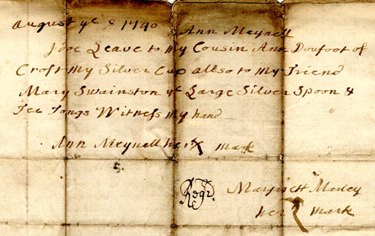The Codicil

Testators frequently had cause to supplement or change the terms of their wills. The codicil was the easiest means of doing so without having to go to the trouble and expense of redrafting a new will. Moreover, as codicils followed the form of the last will rather than the testament, so not requiring the nomination of executors, they could be quickly drafted, needing only the signatures of the testator and two witnesses. The same terms of qualification for testaments also applied to those who might make and witness codicils. A codicil in the testator's own handwriting is often supported by affidavits as to the handwriting and the discovery of the codicil, even where the probate or administration of the will and codicil was not contested and passed the court in common rather than solemn form of law.
Nuncupative codicils could also be made, though subsequent to the Statute of Frauds in 1677 testators could not use such codicils to devise real estate. Like a testament, it was not necessary to date a codicil, however, it was possible for more than one codicil to be valid, in contrast to the case for wills. Should a later codicil contradict a former codicil, the latter prevailed, but unlike as was the case with wills, two undated and contradictory codicils were both still valid, duplicate bequests having to be divided.
The above example of a nuncupative codicil was made by William Richardson of East Thriston in the parish of Felton, a tenant of the Earl of Northumberland. Richardson had first made his nuncupative will on 10 July 1637 'beinge affraid of the infeccon of the plague', and rightly so, for a week later he had been infected, and drew up a nuncupative codicil in which he gave two additional bequests to his brother and sister.
An important function of the codicil was as a means of substituting executors, should an executor have subsequently died or renounced that duty. However, a testament defective in its failure to nominate any executor could not be perfected by doing so in the codicil. This point speaks to the genesis of this instrument in Roman civil law, and which has been termed an 'unsolemn form of will' rather than a form of testament, in that a person may direct via a codicil any matters which may legally be done after his death without the agency of an executor. Consequently, persons might die intestate but with a valid codicil, and a valid codicil might antedate a valid last will and testament, or indeed a codicil can still be valid even if the will is lost. As such, codicils were at first used when a testator did not have the means or time to perform a full solemn testament. But in England in this period codicils became almost exclusively the preferred means to amend an existing testament, and it is in this sense that the meaning of 'codicil' or little book or writing carries most sense, a will with a codicil sometimes being described as a 'great' and 'little' book or will. The nice distinction has been noted that the term nuncupative codicil is in fact a paradox, and such instruments should be termed as something in the place of a codicil.
This is an example of a codicil in which the testator, John Davison of Bishopwearmouth, taking a dim view of the behaviour of two his children, changed the original terms of his will made seven years earlier in 1814 in order to disinherit them. He went on to state that he considered his son 'in the same light as a stranger in blood'. The codicil is clearly dated and was signed and sealed by the testator in the presence of three witnesses before being securely attached to the will which it modifies. The codicil was drawn up in 1821, but although Davison did not die until May 1844, the will and codicil being proved at Durham in January 1846, it appears he did not relent or further alter the terms of his will.
Sources:
BURN, R. Ecclesiastical Law (London, 1797: online resource -
Codicils).
GODOLPHIN, J. The Orphans Legacy: or, A Testamentary Abridgement (London: 1674: online resource -
Codicilssub).
SWINBURNE, H. A (briefe) treatise of testaments and last wills (London, 1590: online resource
-
Codicilssub).
DPRI/1/1637/R6/1 Nuncupative codicil of William Richardson of East Thriston, 17 July 1637.
DPRI/1/1741/M3/2 Codicil of Anne Meynell of Crossgate, Durham City, 9 August 1740.
DPRI/1/1846/D5/8-9 Codicil of John Davison of Bishopwearmouth, 20 February 1821.




